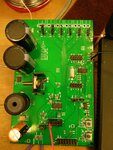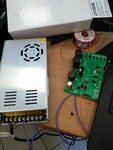Alper özel
Member level 1
- Joined
- Feb 28, 2015
- Messages
- 40
- Helped
- 0
- Reputation
- 0
- Reaction score
- 0
- Trophy points
- 6
- Location
- Turkey / Scotland
- Activity points
- 487
Using TPS61196 LED Driver chip for high Voltage Backlight applications
I need to design a Backlight Driver which has to have high brightness.
These are the equipments I have in the design:
These are the features I need to cover:
-I need to draw at least 350 mA from one channel(28 LEDs)
-I need to adjust the Duty cycle 20% @ 120 Hz
-When I draw 350 mA from 28 LEDs, output voltage will rise to about 28 * 3V = 84V + ~1V(Headroom) = 85V
-I use 2 channels currently(each channel drives 28 LEDs in series) so 350 mA * 2 = 700 mA current needed to be boost
I will apply synchronised PWM dimmnig to 2 channels @ 120 Hz with 20% duty cycle
So designed this circuit (I took my reference design as TPS61196 EVM module). I followed the design guide carefully. Double checked the calculations. Yet, the circuit does not work. No strobe at all! Here is the schematic:You can download the SmartPDF file of both the schematic and the PCB here.
I tested the circuit in anyway I thought. Short circuits, wrong soldering, misplacement of components etc. checked for anything might be wrong, but everything was as in my design. So, I do not know what to do next. Maybe somebody here might have used the same chip and encountered the same problem. I am desperate **broken link removed**.
Only clue I have is this. I thought maybe, boost regulator is not working properly so I used another LED string which works with estimated 12V supply(When I apply 12V it lights up) and set the supply voltage to 12V. Because the initial IFB pin was 3.5V. Then I increased the supply voltage to 24V and I saw the initial IFB pin is increased as well to 16V. I could not see anything about this issue in the datasheet. I hope someone can help.


I need to design a Backlight Driver which has to have high brightness.
These are the equipments I have in the design:
- My Backlight String combined of 2 parallel of 28 serial LEDs(2 * 28 = 56 LEDs)
- My LED Driver Chip is TPS61196
- My supply is 24V 15A 350W SWİTCH MODE ADAPTOR
- My switching N-Channel Transistor is IRL640A
These are the features I need to cover:
-I need to draw at least 350 mA from one channel(28 LEDs)
-I need to adjust the Duty cycle 20% @ 120 Hz
-When I draw 350 mA from 28 LEDs, output voltage will rise to about 28 * 3V = 84V + ~1V(Headroom) = 85V
-I use 2 channels currently(each channel drives 28 LEDs in series) so 350 mA * 2 = 700 mA current needed to be boost
I will apply synchronised PWM dimmnig to 2 channels @ 120 Hz with 20% duty cycle
So designed this circuit (I took my reference design as TPS61196 EVM module). I followed the design guide carefully. Double checked the calculations. Yet, the circuit does not work. No strobe at all! Here is the schematic:You can download the SmartPDF file of both the schematic and the PCB here.
I tested the circuit in anyway I thought. Short circuits, wrong soldering, misplacement of components etc. checked for anything might be wrong, but everything was as in my design. So, I do not know what to do next. Maybe somebody here might have used the same chip and encountered the same problem. I am desperate **broken link removed**.
Only clue I have is this. I thought maybe, boost regulator is not working properly so I used another LED string which works with estimated 12V supply(When I apply 12V it lights up) and set the supply voltage to 12V. Because the initial IFB pin was 3.5V. Then I increased the supply voltage to 24V and I saw the initial IFB pin is increased as well to 16V. I could not see anything about this issue in the datasheet. I hope someone can help.


Last edited: